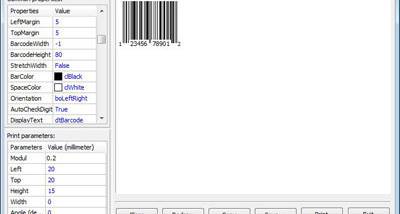

- #1d barcode generator pdf#
- #1d barcode generator generator#
- #1d barcode generator code#
Also, we need to convert the form referenced by the codeFormObject instance into an Image instance (line 17).Here we need to pass the pdfDocument instance.

Next, we create an instance of the PdfFormXObject class from our codeFormObject variable (line 16).This instance is assigned into the codeFormObject variable to be used next.
#1d barcode generator code#
First, we need to create an instance of the BarcodeQRCode class dedicated to handling the QR code where we pass the barcode value (to be encoded into the QR code) as the constructor argument (line 15). To create our first QR code, we should proceed with several steps in order to add a barcode instance into the pdfDocument properly.This instance represents the root element where any desired content can be added (lines 11-13).
#1d barcode generator pdf#
Create an instance of the PdfDocument class as the pdfDocument variable will be used as the main entry point to the PDF content. To start QR code generation, follow these steps: QR CodeĪ QR code (abbreviated from Quick Response code) often contains data for a locator, identifier, or tracker that points to a website or application. Let's start with QR codes as this barcode is pretty common these days. IText 7 supports, as already mentioned, only two types of 2D barcodes: QR codes and Data Matrixes. Matrix or multi-dimensional (2D) barcodes are represented by black and white "dots." These barcodes are compact and capable of holding high-capacity symbols in the unit area. Additionally, my project has recently been upgraded to the latest libraries (Spring Boot 2.4.2 and iText 7.1.14). Please check my previous article where I covered that. Prerequisite: All the codes below, expect iText 7, are basic knowledge. Therefore, I'll begin with an explanation of generating the 2D barcodes, because there are only two of them. The section dedicated to 1D barcodes contains some generalization as there are five supported barcodes. Nevertheless, I believe the library supports all the common ones. IText 7 library supports many barcodes, but not all the options mentioned on Wikipedia. In general, we recognize two basic barcode types: If you want to see some examples of barcodes, please check the barcode sheet on their site. Most barcode standards are managed by the GS1 organization. 
Here is a simple definition of ‘barcode’ according to Wikipedia:Ī barcode or bar code is a method of representing data in a visual, machine-readable form. Firstly, I'll provide a short overview of barcodes, and then demonstrate barcode generation for every supported barcode type in the library. Here, I focus on the barcode support provided by the iText 7 library. The Code 128 Auto barcode type is easily read and verified with the IDAutomation USB Barcode Scanner.In my previous article, I reviewed the basics of iText 7.
#1d barcode generator generator#
A free online barcode generator is also available for testing purposes. The above Code 128 Auto barcode symbol was generated with the Barcode Image Generator at 96 DPI. Code 128 Auto barcode encoding “BC12345678”. These options exist in the Native Barcode Generators for Crystal Reports, Access, FileMaker, JavaScript and Oracle Reports.įig.
Nat_Code128a creates a “native” barcode from pure text without installing fonts or components. The Code128 barcode option in all Components and Applications will produce a barcode image that includes all applicable start and stop digits with checksum characters when required. Using Uni_Code128 with a Universal Barcode Font Encoder returns text formatted to the Universal Barcode Font and the GS1 DataBar Barcode Font. Using Code 128 Auto Barcode Fonts with a font encoder returns text formatted to the Code 128 Barcode specifications. The ApplyTilde option is available in Auto mode, which enables other options such as the easy generation of GS1-128 barcodes. Code 128 Auto generates the most area-efficient barcode symbol and easily encodes ASCII 0-126, which includes numbers, upper and lower case letters, several symbols, and the GS1 FNC-1 function. 
The Code 128 Auto barcode specification is used in IDAutomation Barcode Fonts, Components and Applications to create a Code 128 Auto Barcode with automatic character set switching.








 0 kommentar(er)
0 kommentar(er)
